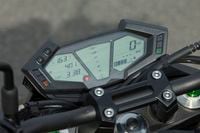Not always a hotbed of activity, the "middleweight standard" segment has been hopping, largely because Yamaha dropped the cheap and raucous three-cylinder FZ-09 into the mix in 2014. Since then, Suzuki's rebadged its European 750 into the GSX-S750, and now Kawasaki makes it a trio with the Z800. Also brought over from across the Atlantic, where it debuted in 2013, the Z800 is intended to tackle inner city roads and tight mountain corners alike. A roadster's work, like we said.
At $8,399, the Z800 sits at the top of the price range for the Japanese segment, considering the FZ-09 at $8,190 and the GSX-S750 at $7,999 (both, it should be noted, without ABS). Various versions of the Z are offered in Europe, including reduced power (to comply with licensing classes) and non-ABS models. We get the ABS model only, and you can have it in any color you like, as long as it’s black (with green accents, of course.) Oh, and by “we” we mean everyone but Californians. For now the Z800 is not available in the Golden State.
Powering this midsized streetfighter is Kawasaki’s DOHC liquid cooled 806cc inline four. It's a familiar engine, having debuted in the 2004 Z750, itself just a sleeved-down version of the contemporary Z1000 powerplant. Now it's an 800, carrying a 2.7mm-larger bore but retaining the Z750's 50.9mm stroke. Engine feel is smooth, with little vibration at the low end and in the midrange. Get it above 8,000 rpm, though, and it starts to get buzzy. Power output is plenty to have fun, without being overwhelming—we’d love to tell you how much, but Kawasaki doesn’t say. (The last Z750 we tested, in 2005, made 100.9 hp and 51.8 pound-feet of torque; the last Suzuki GSX-S750 we had made 95.3 hp at the rear wheel.) Thanks to conventional fuel injection with mechanical throttles (not ride-by-wire), response is even and accurate, thankfully not as jumpy as the 800’s big-brother Z1000. The Z’s six-speed transmission shifts smoothly and decisively, and the torquey engine allowed me to keep it in fourth gear almost all the way up moderately fast, open mountain road.
Now let’s talk suspension. As an FZ-09 owner, I’ve grown somewhat accustomed to the near pogo stick-like performance of its suspension, though taking on rough road surfaces (especially with some lean angle) often turns into a pucker moment. In contrast, Kawi’s Z800 is a welcome respite from the FZ’s bouncy ride, with appropriate spring rates and enough damping for the job. It gets there with a 41mm inverted KYB fork featuring adjustable spring preload and 26 clicks of rebound-damping adjustment. At the other end, there’s a KYB piggyback reservoir shock with 2.5 turns of rebound adjustment and stepless spring preload. This setup gave the Z a firm, planted ride through the sweeping turns of Hwy 74 out of Palm Springs, without sacrificing much comfort around town. Road feel over sharp-edged bumps transferred more to the seat than I would like, but over rolling bumps the Z800 felt just compliant enough to keep me in the saddle.
Braking power on the Z800 is strong enough to bring the 509-pound (claimed, wet) bike to an assured stop. (Yes, that's 95 pounds heavier than an FZ-09.) The four-piston Nissin front calipers gripping 310mm rotors gave enough brake feel to invoke confidence in stopping power, without too much initial bite. Experienced riders might wish for more braking aggression, but the target market for the Z will likely think them just fine. The rear single-piston caliper squeezing the 250mm rotor felt softer than I would prefer, certainly softer than the rear brake I’m used to on the FZ-09. Given the Kawasaki’s ABS system, the Z never had me worried about stopping in time.
I found the riding position on the Z800 comfortable overall. The handlebar height allowed for a mostly upright stance, with a little more forward lean than the FZ-09, which is great for sporty riding. The Kawi’s 32.8-inch seat height and narrow profile were well suited to my 30-inch inseam, though the saddle was a bit on the firm side. Footpegs felt a little higher than my FZ-09’s, making the leg position feel slightly more cramped, though more appropriate for sporty riding once we hit the twisties.
So, has Kawasaki hit the mark of building an in-town bike that also offers sporty riding capability? My answer is a resounding yes, and that’s from the perspective of someone who owns one of its competitors. I am happy enough with my FZ—and the triple’s snarl is a big part of it—but in terms of overall capability, the Z800 is right there with it. Really, it’s a matter of personality, with the Z800 (like the GSX-S750), a somewhat mellower, more conventional offering in the class. Extra points for the better suspension and ABS. With bikes like these, it’s obvious why the middleweight roadster class is popular.






























/cloudfront-us-east-1.images.arcpublishing.com/octane/HXOUJXQWA5HBHGRO3EMJIGFMVI.jpg)

/cloudfront-us-east-1.images.arcpublishing.com/octane/3TIWWRV4JBBOLDVGRYECVVTA7Y.jpg)
/cloudfront-us-east-1.images.arcpublishing.com/octane/KIX5O23D5NAIBGFXBN3327DKZU.jpg)
/cloudfront-us-east-1.images.arcpublishing.com/octane/7GJYDUIPXRGMTMQKN6ONYOLBOU.jpg)
/cloudfront-us-east-1.images.arcpublishing.com/octane/MUQLOVLL2ZDGFH25ILABNBXKTI.jpg)
/cloudfront-us-east-1.images.arcpublishing.com/octane/TNOU5DNE2BC57MFPMGN2EIDXAM.jpg)
/cloudfront-us-east-1.images.arcpublishing.com/octane/GTCXACQGJ5HAPDTGWUQKDEH44E.jpg)
/cloudfront-us-east-1.images.arcpublishing.com/octane/S35YGSEMEZB4BLTDJTSZPF4GLA.jpg)
/cloudfront-us-east-1.images.arcpublishing.com/octane/5UOT6HPX2JFMRJAX6EH45AR4MQ.jpg)
/cloudfront-us-east-1.images.arcpublishing.com/octane/OKWOJWAKP5EP3OACCRRWPCIX2Q.jpg)
/cloudfront-us-east-1.images.arcpublishing.com/octane/2WF3SCE3NFBQXLDNJM7KMXA45E.jpg)
/cloudfront-us-east-1.images.arcpublishing.com/octane/G4MG6OUCJNBSHIS2MVVOTPX65E.jpg)
/cloudfront-us-east-1.images.arcpublishing.com/octane/IIGGWFOTOJGB7DB6DGBXCCMTDY.jpg)
/cloudfront-us-east-1.images.arcpublishing.com/octane/QSTCM6AVEZA5JJBUXNIQ3DSOF4.jpg)
/cloudfront-us-east-1.images.arcpublishing.com/octane/U4I7G625B5DMLF2DVIJDFZVV6M.jpg)
/cloudfront-us-east-1.images.arcpublishing.com/octane/B6XD6LS6IVCQPIU6HXDJSM3FHY.jpg)
/cloudfront-us-east-1.images.arcpublishing.com/octane/ICL63FEDDRDTTMINYICCEYGMDA.jpg)
/cloudfront-us-east-1.images.arcpublishing.com/octane/FCGZHQXRBZFLBAPC5SDIQLVF4I.jpg)
/cloudfront-us-east-1.images.arcpublishing.com/octane/WNOB6LDOIFFHJKPSVIWDYUGOPM.jpg)

/cloudfront-us-east-1.images.arcpublishing.com/octane/X33NU3E525ECRHXLNUJN2FTRKI.jpg)
/cloudfront-us-east-1.images.arcpublishing.com/octane/6KKT5NNL2JAVBOXMZYS5ZO76YA.jpg)
/cloudfront-us-east-1.images.arcpublishing.com/octane/J5RKG5O455GMPGQRF2OG6LRT7A.jpg)